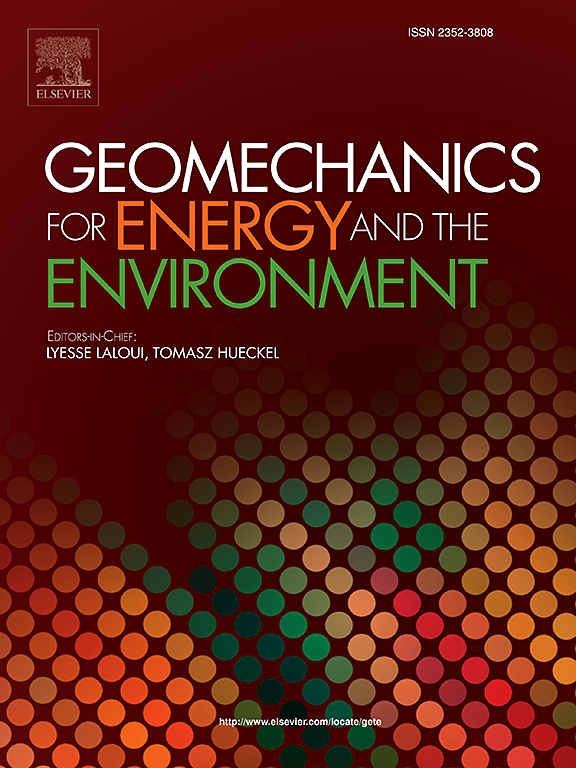Soft interface instability and gas flow channeling in low-permeability deformable media
IF 3.3
2区 工程技术
Q3 ENERGY & FUELS
引用次数: 0
Abstract
Understanding gas percolation through a clay layer or a shale formation is of great importance for the development of a geologic repository for nuclear waste disposal, a subsurface system for gas storage, and an engineering approach for hydrocarbon extraction from unconventional reservoirs. Gas injection experiments have revealed complex dynamic behaviours of gas percolation through water saturated compacted bentonite, characterized by a high breakthrough pressure, rapid breakthrough, a pressure/stress decay after the breakthrough, a relatively high migration rate, high-frequency periodic/nonperiodic variations in flow rate, stepwise rate reductions during relaxation, and low gas saturation over the whole process, all indicating channelling nature of the processes. Using linear stability analyses, we show that this channelling can autonomously emerge from the instability of the deformable interface between the injected gas and the compacted bentonite matrix driven by local stress concentration, pore dilation, and hydrologic gradient. Channel patterns formed would possess a fractal geometry. We further show that, once a percolating channel is established, the gas injected would percolate through the channel in a chain of gas bubbles, also due to the interface instability, resulting in periodic/chaotic variations in gas flow rate. Our work provides a unified explanation for key features observed for gas percolation in low-permeability deformable media. The work also suggests a possibility of designing an engineered barrier system for a nuclear waste repository that can have controllable gas release while limit water transport.
低渗透变形介质中软界面失稳与气体窜流
了解通过粘土层或页岩层的气体渗流对于开发核废料地质处置库、地下储气系统以及非常规储层油气开采的工程方法具有重要意义。注气实验揭示了饱和水压实膨润土中气体渗流的复杂动态行为,具有突破压力大、突破速度快、突破后压力/应力衰减、运移速率较高、流速高频周期性/非周期性变化、弛缓过程中速率逐步降低、整个过程含气饱和度低等特征,表明该过程具有通道性。通过线性稳定性分析,我们发现,在局部应力集中、孔隙膨胀和水文梯度的驱动下,注入气体和压紧的膨润土基质之间的可变形界面不稳定,会自动产生这种通道。形成的水道图案将具有分形几何。我们进一步表明,一旦渗透通道建立,注入的气体将以气泡链的形式通过通道渗透,同样是由于界面的不稳定性,导致气体流速的周期性/混沌变化。我们的工作为低渗透可变形介质中观察到的气体渗流的关键特征提供了统一的解释。这项工作还提出了为核废料储存库设计一个工程屏障系统的可能性,该系统可以控制气体释放,同时限制水的输送。
本文章由计算机程序翻译,如有差异,请以英文原文为准。
求助全文
约1分钟内获得全文
求助全文
来源期刊

Geomechanics for Energy and the Environment
Earth and Planetary Sciences-Geotechnical Engineering and Engineering Geology
CiteScore
5.90
自引率
11.80%
发文量
87
期刊介绍:
The aim of the Journal is to publish research results of the highest quality and of lasting importance on the subject of geomechanics, with the focus on applications to geological energy production and storage, and the interaction of soils and rocks with the natural and engineered environment. Special attention is given to concepts and developments of new energy geotechnologies that comprise intrinsic mechanisms protecting the environment against a potential engineering induced damage, hence warranting sustainable usage of energy resources.
The scope of the journal is broad, including fundamental concepts in geomechanics and mechanics of porous media, the experiments and analysis of novel phenomena and applications. Of special interest are issues resulting from coupling of particular physics, chemistry and biology of external forcings, as well as of pore fluid/gas and minerals to the solid mechanics of the medium skeleton and pore fluid mechanics. The multi-scale and inter-scale interactions between the phenomena and the behavior representations are also of particular interest. Contributions to general theoretical approach to these issues, but of potential reference to geomechanics in its context of energy and the environment are also most welcome.
 求助内容:
求助内容: 应助结果提醒方式:
应助结果提醒方式:


